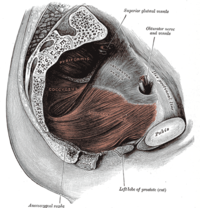
Photo from wikipedia
This journal recently published a paper by Yu et al., entitled ‘Predictors of Outcomes Following Interdisciplinary Acceptance and Commitment Therapy for Chronic Pain: Profiling Psychological Flexibility’ (Yu et al. 2022).… Click to show full abstract
This journal recently published a paper by Yu et al., entitled ‘Predictors of Outcomes Following Interdisciplinary Acceptance and Commitment Therapy for Chronic Pain: Profiling Psychological Flexibility’ (Yu et al. 2022). Acceptance and commitment therapy (ACT) has received a great attention because of its efficacy in lowering psychological and physical disability and improving functioning and quality of life in patients with chronic pain. Little is known about who is most likely to benefit from this treatment and research on predictors of outcome treatment have generated inconsistent findings. To date, studies have mainly focused on the role of psychological flexibility (PF) to predict outcome treatments (i.e., by increasing psychological flexibility). PF is the capacity to persist with or change behaviour in a context of personal goals, psychological influence and situational prospects. Three clinicallyrelevant PF profiles reflecting different levels of pain acceptance, self ascontext and committed action at baseline were identified through clustering methods. About 12% of patients were in the ‘low PF’ (i.e., low levels of all PF processes), 63% were in ‘low openness’ (i.e., low level of pain acceptance and a medium level of selfascontext and committed action) and about 25% were identified in the ‘high awareness and action’ (i.e., a medium level of pain acceptance and relatively high level of selfascontext and committed action). Participants in these profiles scored differently on measures of pain intensity, pain interference and mood at baseline, but did not appear to respond significantly to the treatment in a different way. This study provides fresh knowledge to the field of understanding of predictors of ACT outcomes even if baseline PF does not seem to consistently predict treatment outcomes. The authors adopted a theoretically guided approach to investigate PF processes as treatment predictors along three dimensions (acceptance, selfascontext and committed action). The findings may be valuable in guiding the selection of potential predictors in future research, since effective techniques and questionnaires are readily available to target PF processes. Finally, investigating theoretically derived treatment predictors can help test the model and refine the theory. The first remark concerns the measure of PF processes. The measures included in the present study were all limited to selfreports. Errors in completion, depressive symptoms or fatigue rather than pain could have influenced results. Selfperception in addition may be biased by the individual's tendency to report socially desirable responses and favourable selfpresentation (Crowne & Marlowe, 1960). Social desirability is defined by the need to preserve vulnerable selfesteem and avoidance to social disapproval. Social desirability which is rarely considered in the studies varies across individuals and context. However, the utilization of online questionnaires should have minimized its effects. It should also be noted that two of the three selfreported questionnaires were not validated for patients with chronic pain. This issue is mentioned by the authors as a limitation in the article. However, we would like to point out that specifically validated tools for chronic pain gather more accurate information on these patients' experience. Finally, the question of sensitivity of PF measures for longitudinal evaluation, that is their abilities to capture change in response to treatment over time, is of importance for future investigations. We have no doubt that the authors have the means to improve some of these aspects considering their expertise in the domain. We should also consider the findings of the current study under the prism of cognitive functioning. We regard
Journal Title: European Journal of Pain
Year Published: 2022
Link to full text (if available)
Share on Social Media: Sign Up to like & get
recommendations!